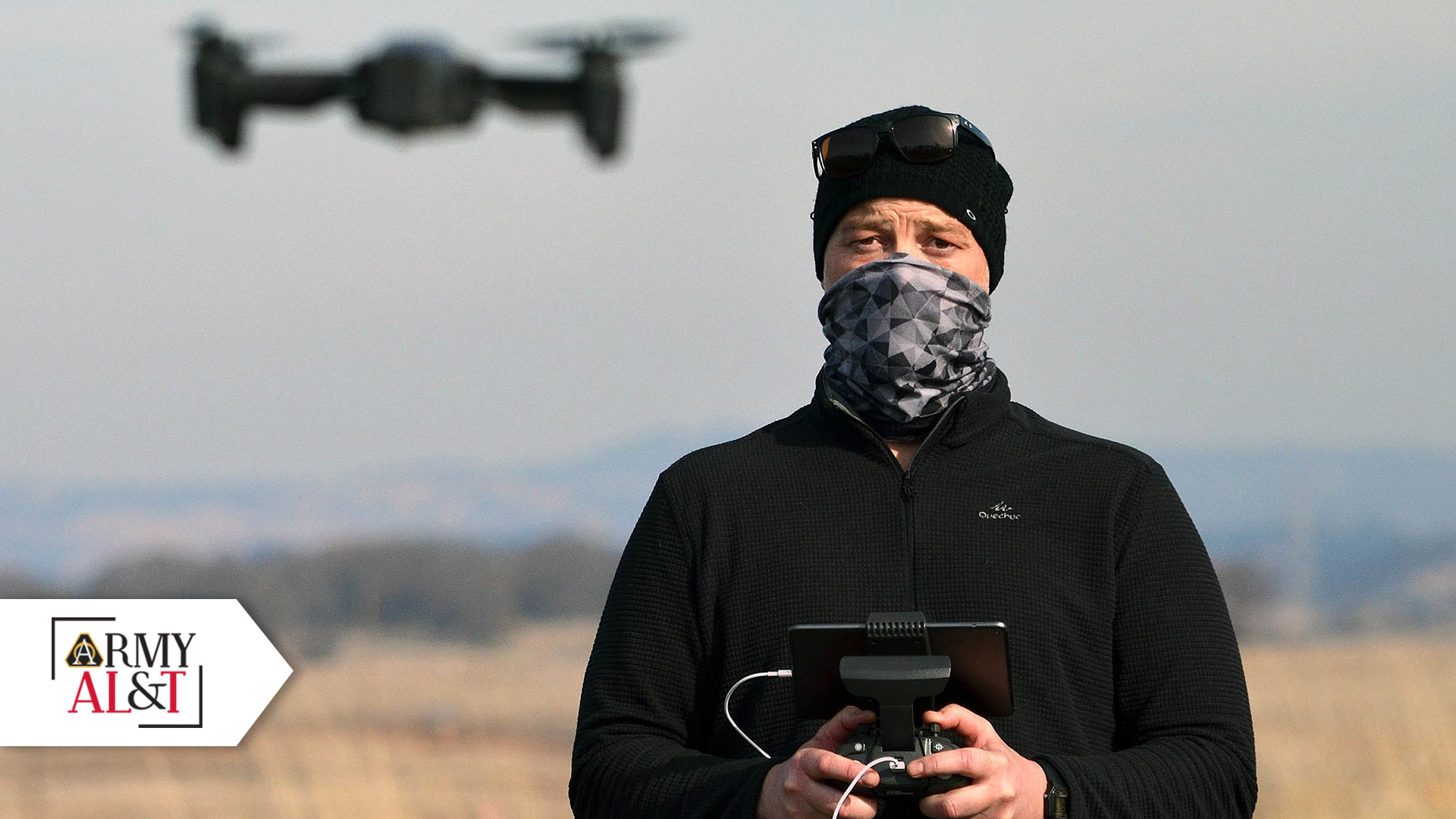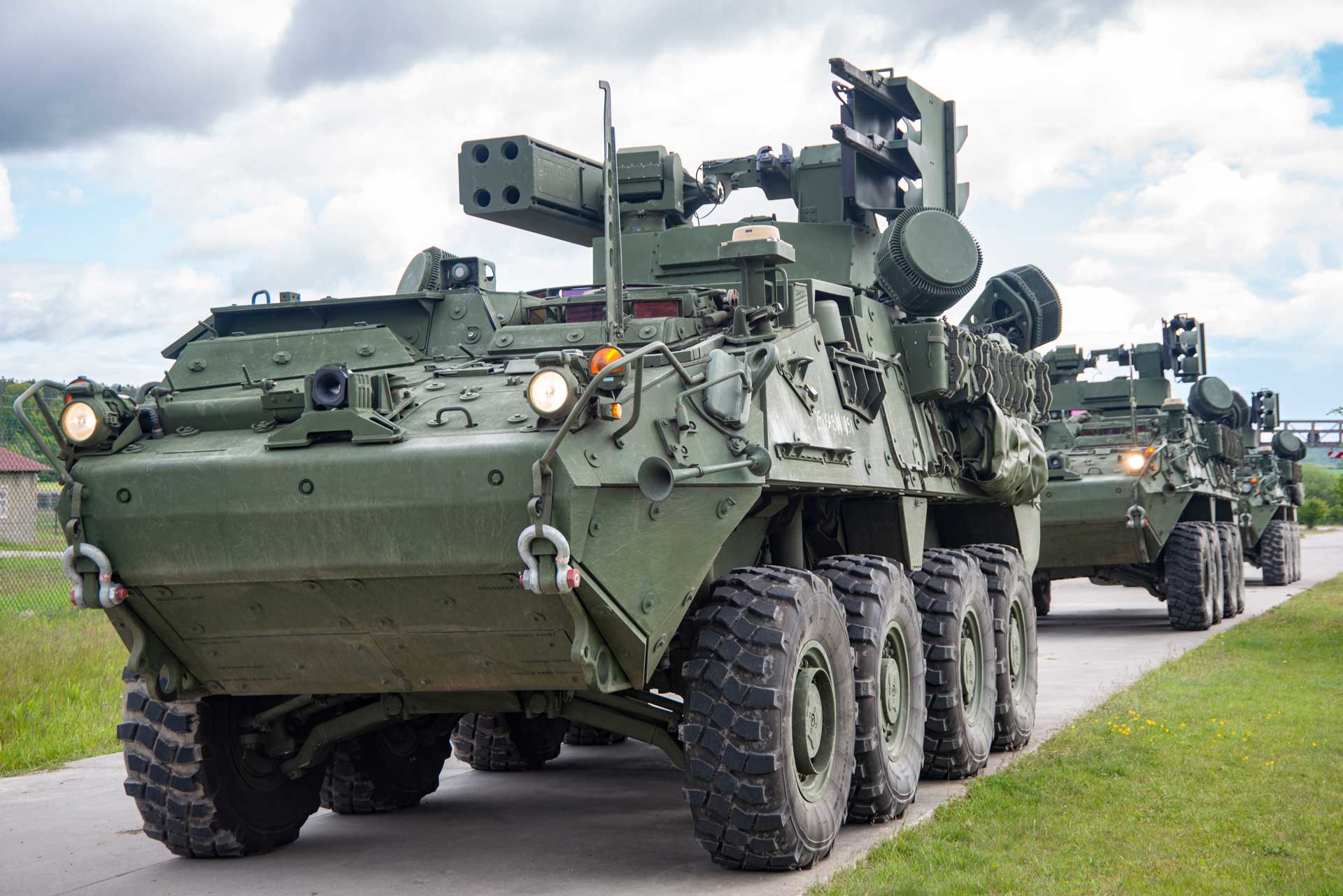
DRONES ‘R’ US: As drones have become more advanced, less expensive and more widely available, DOD has shifted its approach to dealing with the threats they pose to troops in combat. MMPA helps to counter drone threats including swarms. (Photo by Joseph P. Bruton, U.S. Army Corps of Engineers)
Product Manager Medium Caliber Ammunition leads collaboration for countering drone threat by upgrading platforms’ armament systems.
by Kaitlyn Tani and Anthony Amoroso
As air threats like unmanned aerial systems (UAS) proliferate on the battlefield, the need for self-defense armaments on military vehicles becomes imperative—but with persistent constraints on weight and size. Small caliber systems, such as the .50-caliber M2 machine gun, have been the traditional solution for carrier vehicles, but enemies are increasingly exploiting small, fast, inexpensive UAS—even a mass-produced hobby quadcopter can now be used to ascertain the position and size of a ground force—and small caliber ammunition can no longer keep up. Vehicles designed to carry Soldiers must maintain the ability to maneuver quickly across the battlefield. Larger caliber ammunition, while eminently effective, requires heavy weapon systems, which can limit speed and agility. Thus, medium caliber ammunition became the preferred means to counter the UAS threat and Product Manager Medium Caliber Ammunition (PM MC) is collaborating across the enterprise to provide enhanced capability.
In response to a joint operational needs statement for counter-UAS capability and a direct requirement for self-defense, PM MC—under Project Manager Maneuver Ammunition Systems (PM MAS) and the Joint Program Executive Office for Armaments & Ammunition (JPEO A&A)—has reacted with an urgent materiel release strategy to fulfill the requirements for self-defense and an ammunition solution against drones. In collaboration with stakeholders, including PEO Missiles and Space and U.S. Army Training and Doctrine Command (TRADOC), the 30×113 mm ammunition was selected as the caliber of choice to provide lethality while not increasing vehicle weight significantly.

ATTACK FROM ABOVE: The AH-64 Apache attack helicopter is an example of a fast and maneuverable vehicle that is also very lethal. The 30 mm M789 High Explosive Dual Purpose (HEDP) cartridge has been used successfully on the aircraft for nearly forty years. (Photo by Sgt. Sarah D. Sangster, 25th Combat Aviation Brigade)
SAME WEAPON, NEW USE
For nearly four decades, the 30 mm M789 High Explosive Dual Purpose (HEDP) cartridge has been the tactical cartridge for the AH-64 Apache attack helicopter. Fired from an M230 chain gun at 625 rounds per minute, it provides a storm of air-to-ground fire. As the name implies, it also provides dual capability—lethality against ground enemy personnel targets and the ability to penetrate armored vehicles. If the Army’s leading attack helicopter can achieve high speeds and maneuverability, and also engage with air and ground targets, what limits that capability to just air platforms?
Modernizing the Army does not always mean replacing old technology with new. Instead, it can mean repurposing proven technology for a new use. Take the M230 variant known as the XM914, which provides the capability for self-defense from ground threats as well as air defense, while allowing vehicles to maintain maneuverability. With more range than a 40 mm MK19 and more versatility than the .50-caliber M2, this lightweight weapon became the obvious choice for a host of new vehicles with similar missions—the Joint Light Tactical Vehicle; Mobile-Low, Slow, Small Unmanned Aerial Vehicle Integrated Defeat System; Mobile Short Range Air Defense; and the U.S. Marine Corps Marine Air Defense Integrated System. But a traditional M789 HEDP ammunition fired from a ground platform risks collateral damage if targets are missed in ground-to-air engagements.

VERSATILITY WANTED: The M230 variant known as XM914 provides the capability for self-defense from ground threats as well as air defense, while allowing vehicles to maintain maneuverability. It is the “weapon of choice” for vehicles like the M-SHORAD. (Photo by Georgios Moumoulidis, Training Support Activity Europe)
INCREMENTAL CHANGES
In a joint effort with Combat Capabilities Development Command Armaments Center (DEVCOM-AC) and industry, the M789 HEDP was modified to include a percussion primer and self-destruct fuze feature to provide dual-purpose capability while reducing the threat of collateral damage and unexploded ordnance. The added capability produced a new designation, the XM1198 HEDP – Self Destruct (SD). The self-destruct feature ensures that if projectiles miss their intended targets, they will detonate before hitting unintended targets near the ground. The self-destructing cartridge was developed, tested and approved for an urgent materiel release to support an initial 2021 fielding.
While the XM1198 HEDP-SD provides the hit-to-kill capability and achieves an initial incremental lethality for ground platforms against emerging threats, it has limited effectiveness against enemy personnel and UAS. PM MC continues to partner with DEVCOM-AC and industry to lead the path to smarter lethality. With advances in electronics miniaturization and advanced fuzing, the proximity fuzing capability, previously only found in large-caliber ammunition, has been implemented in the 30mm round. The proximity fuze capability allows the round to detonate when it senses it is near a target, rather than requiring a direct hit.
For comparison, in basketball, when shooting free throws at a standard basketball hoop, even the best player will miss occasionally. But, what if the basketball hoop grew to the size of a hula hoop? You could probably hit nearly every shot, and even take a few steps back and still be just as good. The XM1211 High Explosive Proximity (HEP) cartridge is being developed to provide an increase in effective range, reducing the need for precision and making a larger lethal footprint—essentially increasing the size of the hoop so that every shot counts. The XM1211 HEP is currently being tested and validated for an urgent materiel release to support a projected 2022 fielding.

BIG GUNS: JPEO A&A is leveraging and modernizing the 30×113 mm ammunition used on the Apache’s M230 for the use on the XM914E1 chain gun on new ground platforms such as the Stryker M-SHORAD, pictured. The inset photo shows the XM914E1. (Photo by PEO Missiles and Space)
A LONG-TERM SOLUTION
While the urgent materiel releases have provided our warfighter with the immediate capability through incremental development, PM MC strives to provide enduring, advanced 30 mm munitions for current and future ground platforms. The XM1198 HEDP-SD provides hit-to-kill UAS capability while maintaining armor defeat, and XM1211 HEP provides proximity airburst against drones and personnel. The future generation of 30 mm ammunition will provide those capabilities and more.
Enter the Multi-Mode Proximity Airburst (MMPA) cartridge, currently being developed by PM MC to engage ground and air threats while significantly increasing lethality, with less ammunition, in a multidomain operational environment.
Imagine a Stryker vehicle commander taking fire from enemy troops in a protected position, while also in the direct line of fire of an enemy vehicle and with an enemy drone approaching quickly. He calls a fire mission to the gunner, who sets the weapon system to each of the different targets with the press of a button. He selects the MMPA proximity airburst mode, the weapon launches and the munition bursts within the proximity of the incoming air targets. Seconds later, it bursts above the hidden personnel targets and in point detonation with the vehicle threat. With minimal ammunition, the commander and crew are able to defeat three distinct threats. It’s not science fiction. This 30 mm capability will change previous tactics of avoiding detection because of limited defense capability, and will save the Army from using expensive missile assets at shorter ranges, while providing enhanced ground force protection.
“It is essential to equip the joint warfighter with the immediate capability while developing a game-changing, multifunctional solution to keep pace with an ever-changing threat on the battlefield,” said Kevin Vo, deputy product manager for Medium Caliber Ammunition. MMPA enhances the ability to defend or engage against personnel, counter drone threats including swarms and counter materiel threats in cluttered environments through multimode programmability.

CHAIN OF EVENTS: JPEO A&A is modernizing by making existing munitions better. The .50-caliber machine gun was too light for the task of bringing down unmanned aerial systems. It has adapted the Apache’s chain gun to be truck mounted, and is working on new ammunition that will destroy unmanned systems. (Photo by General Dynamics)
CONCLUSION
As the Army is adapting to fight in multidomain operations, its ammunition is being modernized to do the same. Any Apache pilot will agree that the 30×113 mm ammunition has provided decades of undeniable capability for our warfighter; and now, infantry Soldiers will have that capability as well. While developing the next-generation capability is the ultimate goal, incremental modernization is the Agile approach for reducing the acquisition timeline and improving the efficiency, lethality and effectiveness of legacy systems to keep up with the pace of the threat. “Our future munitions need to be smart and interoperable in order to counter threats in multidomain operational environments. The team’s efforts in providing counter-UAS munition capability is a great stepping stone on the path to munition and Army modernization,” said Lt. Col. Paul Santamaria, product manager for Medium Caliber Ammunition.
This effort can only be successful through collaboration across the enterprise to all reach the same objective—synchronization with TRADOC for requirements development, DEVCOM-AC for research and development, Army Test and Evaluation Center for test and evaluation, acquisition through different program executive offices, industry for manufacturing and development, and Joint Munition Command for materiel release approval. This is the winning combination to provide the right capabilities to the warfighter at the right time.
For more information contact JPEO A&A Public Affairs at rebecca.s.leonard3.ctr@mail.mil.
KAITLYN TANI works JPEO A&A for PM-MAS, currently serving as Cannon Caliber Research Development Test and Evaluation (RDT&E) team lead for PM MC. She has worked at Picatinny Arsenal, New Jersey, in support of the Army for 11 years. She holds an M.S. in mechanical engineering from Stevens Institute of Technology and a B.S. in chemical engineering from Rowan University. She is a member of the Army Acquisition Corps.
ANTHONY AMOROSO works within JPEO A&A for PM-MAS as a matrixed employee from DEVCOM-AC as the project officer for 30 mm counter-unmanned aerial systems. He has worked at Picatinny Arsenal in support of the Army for 17 years. He holds a B.S. in mechanical engineering from Pennsylvania State University.







